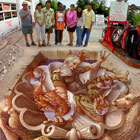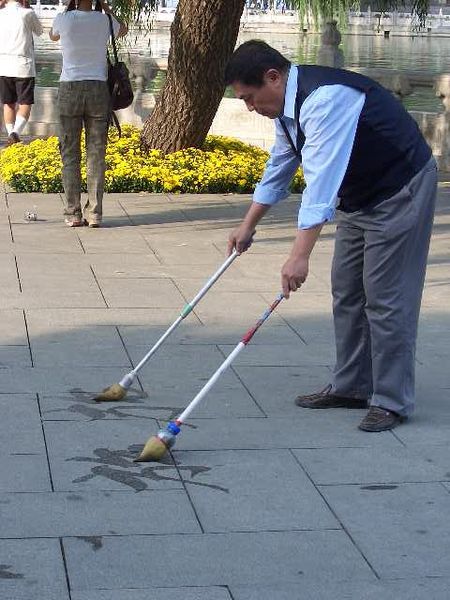It's not exactly calligraphy, but it is artistic expression Renowned Street Artists like Edgar Mueller and Manfred Stader produce really incredible art on paved surfaces all over the world.
Renowned Street Artists like Edgar Mueller and Manfred Stader produce really incredible art on paved surfaces all over the world.  Many of their works are just too unbelievable to imagine. Some of Edgar's and Manfred's artwork include Another incredible artist is Julian Beever who has made pavement drawings for over ten years. He has worked in the U.K., Belgium, France, The Netherlands, Germany, the USA and Australia. The pavement drawings have included both renderings of old masters plus a wealth of original inventive pieces of work. His incredible talent includes rendering of old masters, large pastel
Many of their works are just too unbelievable to imagine. Some of Edgar's and Manfred's artwork include Another incredible artist is Julian Beever who has made pavement drawings for over ten years. He has worked in the U.K., Belgium, France, The Netherlands, Germany, the USA and Australia. The pavement drawings have included both renderings of old masters plus a wealth of original inventive pieces of work. His incredible talent includes rendering of old masters, large pastel  portraits in homage to or in obituary to the famous, and anamorphic illusions drawn in a special distortion in order to create an impression of thee dimensions when seen from one particular viewpoint.
portraits in homage to or in obituary to the famous, and anamorphic illusions drawn in a special distortion in order to create an impression of thee dimensions when seen from one particular viewpoint.
He has a skillful and playful talent and uses his illusions in a variety of ways. Sometimes he even interacts with the art to make his street art’s design part of the work itself. Clearly,  his artworks are as much intended to entertain himself as it is to excite and amuse the crowds that gather around them. His other street graffiti includes renderings of master artworks and pastel portraits.
his artworks are as much intended to entertain himself as it is to excite and amuse the crowds that gather around them. His other street graffiti includes renderings of master artworks and pastel portraits.
Kurt Wenner is an international master artist who interprets Renassance classicism with a thoroughly singular voice. The scope of Wenner's work is not confined to a canvas or limited by a frame. His  visual illusions with street painting has made him famous and has difined some of his artistic expression as "lived in" rather than observed.
visual illusions with street painting has made him famous and has difined some of his artistic expression as "lived in" rather than observed.

This artistic form has not had the exposure it deserves. Thankfully, with the advent of the Internet, many of these artists are being discovered and receiving the attention they justly deserve. You will almost certainly not have had much contact with street painting until now. For many of these artist, street painting is their profession which they have been exercising for years.


















